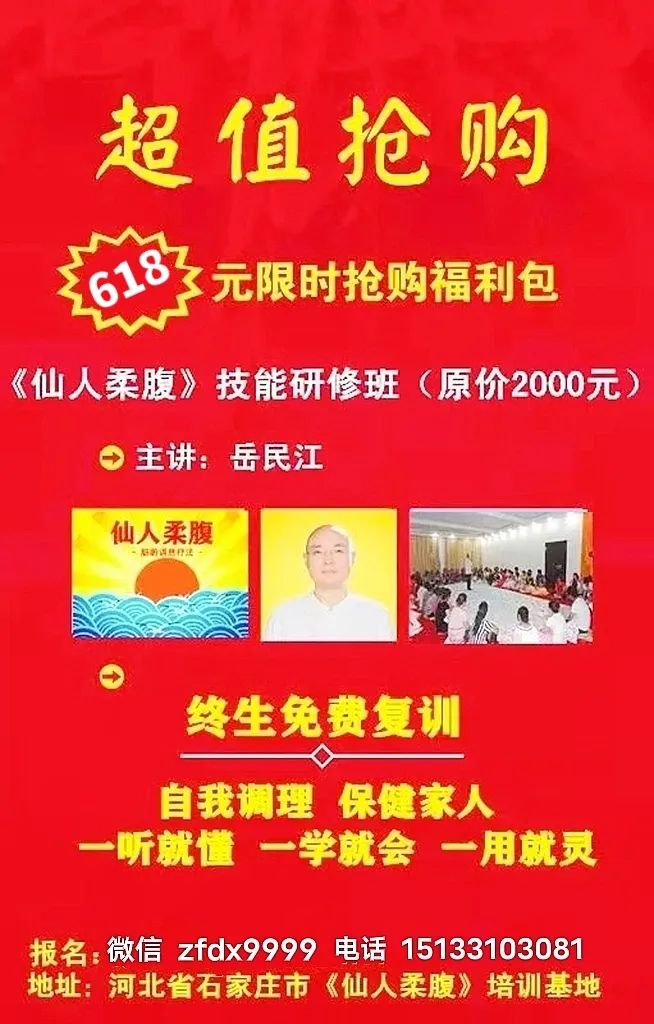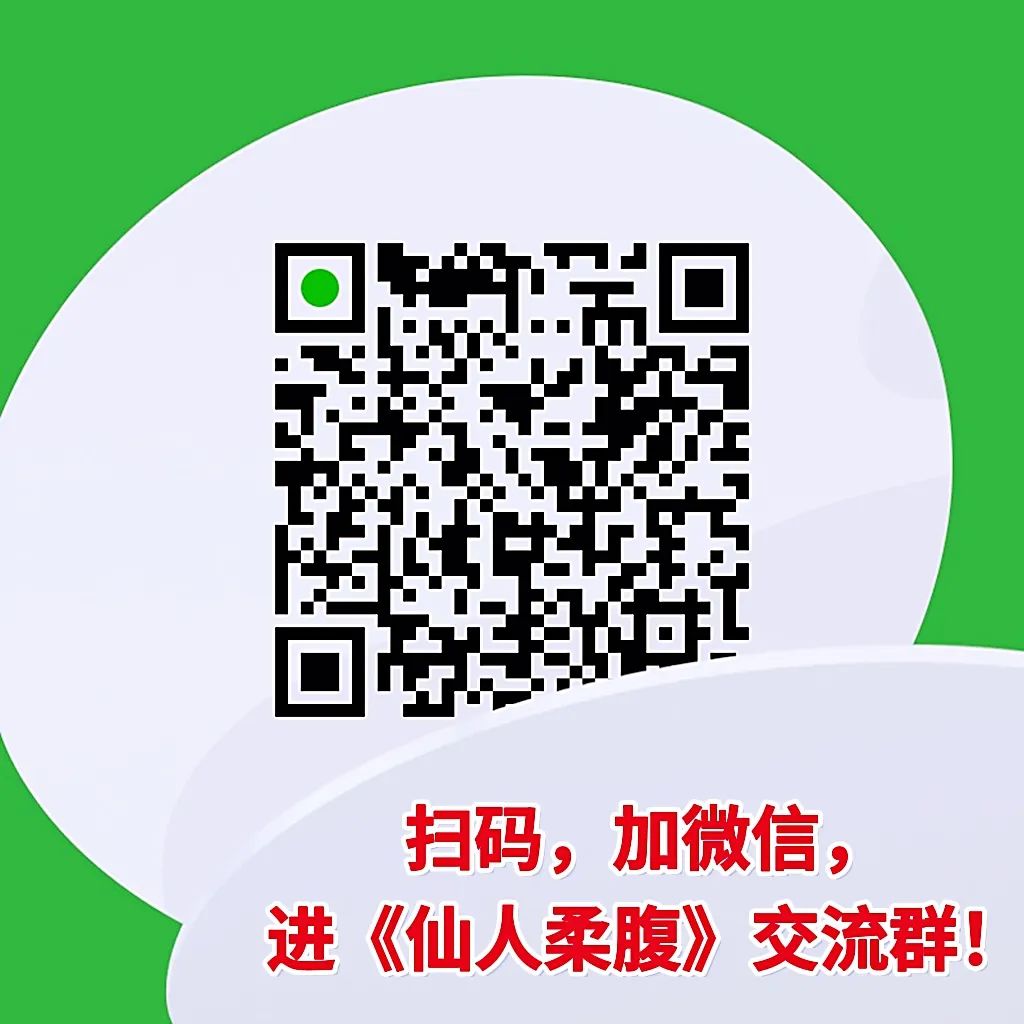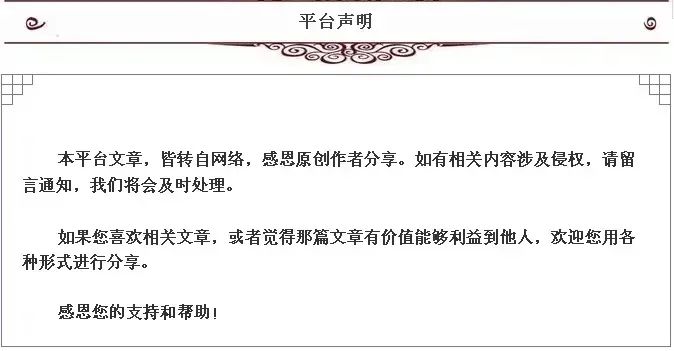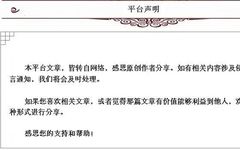I previously studied Teacher Liu’s abdominal pressing technique (Health Selection: Insomnia, Constipation, Lack of Appetite, High Stress, Recommended Abdominal Fitness Therapy!), and I felt great. This time, I have been practicing Daoyin for nearly three months, and after practicing, I feel very comfortable and safe. I recommend it to my friends; why not give it a try?
Teacher Liu said: Daoyin involves lightly touching the center line of the body with the fingers of both hands, and then doing just one thing: quietly feeling the changes in body and mind!
Below, I will briefly share my understanding of the Daoyin method, hoping it will be helpful to everyone:
1. Position: You can sit or lie down, but lying flat is recommended. Bend your fingers and place them lightly on the center line of the body.
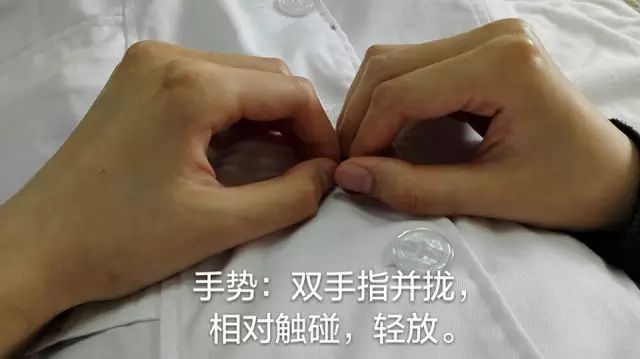
2. Location: You can often place your fingers on the Shanzhong (Zhongfu) point (the midpoint between the two nipples).
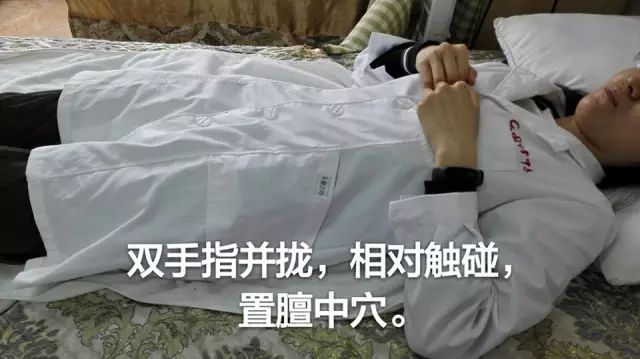
Or on the Shenque (Umbilicus) point (the navel). You can also practice on other parts of the center line of the body. It is recommended to practice on one point for a longer time before changing positions, as this helps to find the feeling.
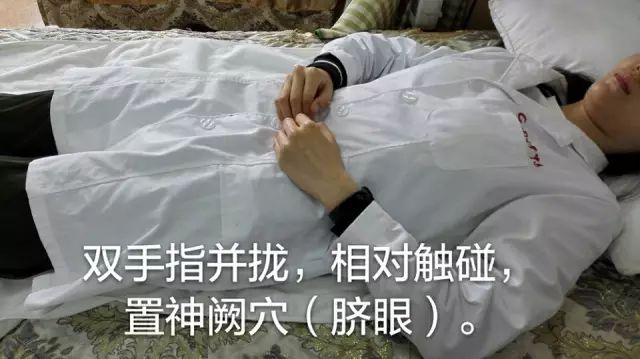
3. Breathing: Relax and breathe calmly or take deep breaths. You may also press your tongue against the roof of your mouth, which might be better!
4. Time: You can practice at any time, preferably before sleep or upon waking, about 5 AM is convenient. It is recommended to practice for more than 30 minutes.
5. Attention: Focus your attention mainly on your fingertips, feel the changes in your fingers, and then experience the subtle changes throughout your body, such as warmth, intestinal peristalsis, numbness, etc. Connect with your feelings!
I suggest you listen to Teacher Liu’s explanations a few more times; you will gain more insights and understanding! Let’s experience it together, and if you have any thoughts or experiences, please leave a comment to share; we can learn and improve together!
The following content is sourced from the internet (https://mp.weixin.qq.com/s/LV5CjM-2YevjNv9QSeQ4gA). If there is any infringement, please inform us to delete it immediately.
Teacher Liu Lihong’s complete video of the public welfare class “Self-Health, Complete Wellness – A Brief Discussion on Daoyin and Anqiao” at Tangchi Tongyou Sanhe TCM in Anhui lasts nearly two hours. Wealthy individuals are advised to watch it in a Wi-Fi environment and to open it in full screen. To save data, you might want to read the text version first!
Content: Recording of Liu Lihong’s lecture
Source: Tongyou Sanhe’s Tangchi
I am very happy to have this time to share some of my feelings about learning TCM with everyone. Today, the main topic is “A Brief Discussion on Daoyin and Anqiao”; in fact, this is a very broad topic. Strictly speaking, Daoyin and Anqiao cannot be fully explained because it is a true skill that must be practiced to understand. However, if we do not discuss it, everyone will not know how to practice, so it is still necessary to talk about it. Today, taking advantage of this precious opportunity, we have leaders from the Anhui Health Bureau, Daoists holding health courses here, and friends from all over the country, so I should talk well and strive to give everyone some insights.
Today’s discussion on Daoyin and Anqiao comes from the “Huangdi Neijing (Yellow Emperor’s Inner Canon) – Suwen” in the section “Different Methods and Formulas”. This text discusses the treatment methods used in TCM, which can be summarized into five categories.
One category is Bian Stone, which is now rarely seen. A few years ago, I visited a Bian stone museum in Xi’an with a friend, which specializes in treatments using Bian stones. The Bian stone therapy originated in the East.
The second category is poisons, in the “Neijing”, all medicines used to treat diseases are called poisons, not just arsenic and mercury. Why? This is something everyone needs to understand, as it relates to TCM’s understanding of health and disease.In TCM, the boundary between disease and health is clearly defined academically. As stated in the “Suwen: Theory of the Balanced Person’s Qi”: “A balanced person does not get sick.” The so-called “balanced person” refers to someone who is not偏 (biased), and balance means “neutral and harmonious”. A balanced person must have a harmonious body, so they do not get sick. Conversely, a “non-balanced person” is someone who is偏 (biased) and will become ill.Since偏 (bias) leads to illness, how do we readjust偏 (bias) back to a non偏 (bias) state? The most common method in TCM is “correcting偏 (bias) with偏 (bias)” or “using偏 (bias) to remedy deficiencies”. Therefore, TCM has treatment principles such as “treating cold with heat”, “treating heat with cold”, “tonifying deficiencies”, and “draining excesses” to restore the body to a balanced state. Thus, the medicines used in TCM have certain偏性 (bias), either偏寒 (cold),偏热 (hot),偏温 (warm), or偏凉 (cool),偏上 (upward),偏下 (downward),偏左 (left), or偏右 (right), and this偏性 (bias) is what the ancients referred to as poison.
The third category of therapy is “Moxibustion”, which is commonly used today with mugwort (Ai Ye), but not only mugwort can be used for moxibustion; many herbs can be used for this purpose, with mugwort being just one of many. In the “Neijing”, it is collectively referred to as moxibustion. Many people have received treatment through moxibustion, which is a convenient and effective method. Moxibustion uses heat, which comes from the North due to its cold climate.
The fourth category of therapy is acupuncture, which has been used for a long time. The “Neijing” discusses acupuncture much more extensively than it does medicines, indicating that over two thousand years ago, acupuncture was the most commonly used therapy, especially in emergencies. Back then, it was not about calling 120 or going to the emergency room; it was acupuncture! Acupuncture has the power to produce immediate effects and even revive the dead. There are nine types of needles, some long, some short, some large, and some small. The first chapter of the “Ling Shu” is called “Nine Needles and Twelve Origins”. The origin of acupuncture is in the South. Why did the nine needles come from the South? Archaeological discoveries confirm that in 1985, two bronze needles were unearthed in Wuming, Nanning, Guangxi, which are the earliest known metal needles. On the other hand, acupuncture requires exposing the body, which can be difficult in cold weather, so the origin of the nine needles in the South may also relate to this factor. The secret of acupuncture is not to be transmitted.
These four methods come from the East (Bian stone), the West (poisons), the North (moxibustion), and the South (acupuncture). What characteristics do they have? Bian stone therapy requires Bian stones, which come from outside the body. Medicines, moxibustion, and acupuncture also come from outside the body, which is a common characteristic.
The fifth method is what we are discussing today: Daoyin and Anqiao. “Daoyin and Anqiao come from the center”, not from the East, West, North, or South, but from the center. The “center” is a significant concept we need to contemplate. Currently, the center of our country is in Beijing, which will determine the direction of China and the fate of the nation. The center certainly has the meaning of being central, but it has a deeper significance. The previous four methods all require some external medium to execute, while Daoyin and Anqiao do not require these mediators; they can occur directly within ourselves. From my personal experience, Daoyin and Anqiao mainly involve self-regulation and self-treatment. Others can help you with Anqiao, but it is not so easy for others to assist you with Daoyin. Therefore, I feel that Daoyin and Anqiao are a very convenient and direct method granted to us by the “Neijing” to achieve self-health and complete wellness.
Recently, my teacher, Mr. Yang Haiying (author of “How to Be at Ease and How to Be Empty”), hosted a reader meeting in Longshan, Beijing, with the theme “Self-Health, Complete Wellness”. I think this theme is excellent and has profound meaning. Today, there are leaders from the Anhui Health Bureau present; in fact, the name “Health Bureau” already indicates that this health comes from outside the body. If health comes from outside, it is impossible for your life, health, or wellness to be complete because true health must come from within. Only autonomous health can lead to complete wellness. Research data from the World Health Organization tells us that treatments or health care obtained in hospitals account for only 8% of the total. This has likely become common knowledge. In other words, even if our hospital treatments and health care are sufficient, they can only account for 8% of overall life and health. Therefore, to seek true health, we must rely on ourselves.
All along, my health has not been very good; I often have minor issues and occasionally suffer from major illnesses, which has caused me much distress. Of course, sometimes distress is not necessarily a bad thing because it motivates you to want to solve it! So, over the years, I have never stopped exploring. A few years ago, I began to touch upon Daoyin and Anqiao. At first, my Anqiao was quite rough, and I could even say a bit random. At that time, I took my father to Jianshan Temple in Shimen, Hunan, for recuperation. Since I was resting in a new place, I woke up around three in the morning. What to do at such an early hour? My hands naturally rested on my abdomen, and I pressed and rubbed, discovering so many painful spots! Finding these painful areas, I kept my hands there, and gradually the pain began to change, eventually lessening or even disappearing, so I moved to another painful spot. Before I knew it, over two hours had passed, and it was already bright outside.
It seemed I was meant to walk this path. The next day, I woke up at the same time again and naturally repeated the process! Everyone knows that the habit of taking a nap is very important for Southerners; if you sleep well during the afternoon, you will have energy in the afternoon. If you do not sleep well at noon, the afternoon will be difficult. However, during those two days, I had no opportunity to rest at noon, yet I found my energy in the afternoon was still acceptable. As a TCM practitioner, I quickly realized this was related to the abdominal pressing I did early in the morning. The so-called abdominal pressing involves finding painful areas in the abdomen and then keeping your hands there (or continuing to press). A key point of abdominal pressing is discovering the painful spots.
What does pain mean? Here, I need to explain a bit. From the character for pain, we can see that it is composed of the radical for illness (疒) and the character for passage (甬). The character 甬 means passage or channel. When the radical for movement (辶) is added to 甬, it becomes通 (to pass). To be通 (to pass) means that the function of the passage is normal, which means that the function of the passage can perform normally. If the passage is not in the radical for movement but in the radical for illness, it means that the passage is “ill”; in other words, the normal function of the passage is lost, and it is not通 (not passing)! What happens when it is not通 (not passing)? Of course, it will hurt! This pain or blockage in the abdomen is related to the intestines! To be more professional, it involves the six fu organs.
So, as I just mentioned, pain or blockage can generally be determined to be a blockage of the six fu organs. And what problems can arise from the blockage of the six fu organs? In the “Suwen: Theory of the Communication of Deficiency and Excess”, there is a famous saying: “The imbalance of the five zang organs is caused by the blockage of the six fu organs.” This clearly tells us that the imbalance of the five zang organs is caused by the blockage of the six fu organs. Thus, we understand that the blockage of the six fu organs can not only lead to changes in the six fu organs themselves but also further cause problems in the five zang organs. Conversely, if the blockage of the six fu organs is resolved, the issues with the five zang organs will also be easily resolved! Through personal experience, I know that abdominal pressing is a very direct method to resolve the blockage of the six fu organs, and according to the teachings of the “Suwen”, once the blockage of the six fu organs is eliminated, the problems of the five zang organs can be naturally resolved. Thinking of this makes me quite excited!
At that time, I had just opened a Weibo account, so I compiled my feelings into “Notes on Abdominal Pressing” to share with everyone. Since I was new to Weibo and did not know about long posts, I had to condense my daily abdominal pressing experiences into 140 characters. Later, knowledgeable colleagues organized it and shared it in link form on Weibo and WeChat, reportedly with a high forwarding rate.
Due to various circumstances, my desire to learn acupuncture gradually matured, and the principles of the acupuncture techniques I learned directly come from the “Suwen: Theory of Yin and Yang Correspondences” which states, “From Yin to draw Yang, from Yang to draw Yin”! Sometimes, many things are indeed quite incredible. The study of acupuncture has led to a certain level of enlightenment for me, and I feel that the Daoyin and Anqiao from the “Neijing” is an extraordinary thing. I can also say that my own Daoyin and Anqiao have gradually reached a better state! It was only at this time that I understood what Daoyin is! Of course, I also realized that many discussions about Daoyin did not hit the point or were not the Daoyin in the “Neijing”. Today, I want to share this method and my feelings with everyone.
However, as I mentioned earlier, Daoyin and Anqiao are indeed a skill, and what is a skill? The ancients said: “The correct method plus time is called skill!” Therefore, it requires time, practice, and you must do it! Just talking is not enough, but I try to clarify it, at least in theory.
This morning, I was organizing my thoughts, looking for an angle that might help our understanding. I want to start with the character for “disease” (疾). The character for disease is first written with the radical for illness (疒). In the past, we might have thought that the radical for illness is just a component, but in fact, it is also a character. I specifically checked the Baidu dictionary today and learned that the correct pronunciation of this character is “ne” in the fourth tone, and it inherently means illness. When the radical for arrow (矢) is placed inside the radical for illness, it becomes disease (疾), which also means illness. Why do both disease and medicine contain the radical for arrow? And the same radical for arrow placed in different contexts has completely different meanings; one is disease, and the other is the treatment of disease (医).
What is the arrow? It is an arrow! There is a well-known idiom: “To have a target”. Therefore, this radical for arrow has a deep connection with the concept of a target. What is a target? It has many meanings, but primarily it refers to the center of a target, so it has the meaning of being central and balanced. Furthermore, according to the explanation in the “Shuowen”, “The target is brightness”, meaning clarity. The target is called brightness, and we need a deeper understanding of this today.
Last year, I was fortunate to be invited by a friend to Luoyang, Henan, and only then did I hear that Xu Shen’s tomb is also in Luoyang. I have a special feeling for characters, and Xu Shen is known as the ancestor of characters, having authored the first dictionary, “Shuowen Jiezi”. Now that I am in Luoyang, how could I miss this opportunity? So, accompanied by a friend, I specially visited Xu Shen’s tomb. In the cemetery, there are many stone tablets, and one of the inscriptions surprised me. We use characters every day, but do you know which character we use most frequently? Many people probably do not know! The most frequently used character is “de” (的)! “De” is the most frequently used character, and does this not have a profound meaning of “brightness”, “balance”, and “truth” for us?!
The process of “having a target” leads us to think of archery, which is one of the six arts of ancient times. The six arts are rites, music, archery, charioteering, writing, and mathematics. Now we can appreciate the character for “archery”; its left side is the character for body (身), and its right side is the character for inch (寸). In Chinese, “inch” refers to the heart, so archery is the combination of body and heart. In the “Liji”, there is a text specifically discussing archery: “When the heart is calm and the body is upright, holding the bow and arrow firmly, then you will hit the target.” “When the heart is calm and the body is upright” is the fundamental requirement for archery. If you can achieve this requirement, the result will inevitably be hitting the target. Although “hit” here is pronounced in the fourth tone, it still has the meaning of the first tone. Thus, through the characters for “arrow”, “target”, and “archery”, we reveal the four essential elements of Chinese culture: “balance and harmony” (with balance being the prerequisite for harmony). This is also the essence of Chinese culture.
Archery is a particularly unique art among the six arts. The “Liji” refers to it as “the way of benevolence”, which is indeed somewhat astonishing. We know that in the era of cold weapons, archery was a remarkable skill. In that era, there were no cannons or missiles; the only means of attack from a distance was archery. Therefore, this skill was a crucial indicator of a nation’s military strength. Yet, it is precisely this art that the “Liji” describes as “the way of benevolence”. It states: “Archery seeks to correct oneself; one must correct oneself before shooting. If one shoots and misses, one does not blame the one who hits; instead, one reflects on oneself.” In the past, archery was often used in competitions. If you lost the competition and did not hit the target, you would not blame the one who did. Instead, you would adjust yourself and further strengthen your own balance, thus continuously improving your archery skills. We often see the saying “When things do not go as planned, reflect on oneself”; this actually comes from archery.
Therefore, “Archery” speaks of the balance of body and mind, and it is precisely this balance that guarantees health. This allows us to understand the deeper meaning of disease; when the arrow is placed in the radical for illness, it deviates from balance. When it deviates from balance, there can be no harmony, and without harmony, can there be health? Thus, when an arrow is placed in the radical for illness, it brings us disease. What is the deviation of the arrow in the radical for illness? Archery tells us it is the deviation of body and mind. When the arrow is placed in the box (匚), the state of deviation is corrected; this is “medicine”! How profound and deep!
At this point, we should understand what medicine is about: it is about achieving balance and harmony! It is about guiding the body and mind back to balance! This is our understanding of medicine and disease. In fact, this can also extend to our understanding of Chinese culture. Once this issue is resolved, we can better understand Daoyin and Anqiao.
Why does Daoyin and Anqiao come from the center? There is profound meaning in this. The center has both the centrality of East, West, South, and North, which belongs to the secular level. Beyond that, Chinese culture also has a non-oppositional level of “center”.
When we talk about opposition, we naturally think of Yin and Yang. Yin and Yang are the most fundamental concepts in TCM, and this has been clearly stated in the “Neijing”. The “Suwen: Theory of Yin and Yang Correspondences” states: “Yin and Yang are the way of heaven and earth, the framework of all things, the parents of change, the source of life and death, and the abode of spirits. To treat diseases, one must seek the root.” From a disciplinary perspective, we can say that everything in TCM is built upon Yin and Yang.
Yin and Yang are inherently opposing concepts. Logically, opposition is a contradiction, and contradictions do not lead to health! If we want to achieve health, we must seek unity from opposition and harmony from contradiction. So, how do we seek unity from the opposing contradictions of Yin and Yang? This is very subtle. For example, the four Qi we often talk about—cold, heat, warm, and cool, as well as their corresponding directions—are all oppositional and contradictory. Therefore, on this basis, there is balanced Qi, which is also called central Qi.
What role does the center (or balanced Qi) play? The center has the function of harmonizing and resolving; it can seek unity from opposition and achieve harmony from contradiction. The center is the foundation of harmony; the center is the guarantee of harmony! The balance of Yin and Yang and the harmony of Yin and Yang all rely on the center to be realized. Why do we call it “Traditional Chinese Medicine”? Do you all understand? The essence of TCM is based on this; if it is not based on this, it cannot be called TCM. Because only by being based on the center can the function of “medicine” occur. The center is profound, and we need to better understand it.
Of course, understanding the center requires a gradual approach, from shallow to deep, from coarse to fine. We first need to understand the center in terms of position, which is the secular level. Where is this center? Let’s first look at the human body; there is a central line on the front of the body, and the meridian along this line is called the Ren Meridian! On the back, there is also a central line, and the meridian along this line is called the Du Meridian. The Ren and Du meridians are the two most important meridians in the human body because only these two meridians dare to occupy the center. To dare to occupy the center means to dare to take responsibility. We just mentioned the foundational and important nature of Yin and Yang in TCM; dividing the body into front and back, the front is Yin and the back is Yang. Therefore, the Ren Meridian, which is in the front center, governs all Yin, while the Du Meridian, which is in the back center, governs all Yang. In other words, if we want to regulate the Yin and Yang of the human body, the main control and switch are in the Ren and Du meridians!
“Daoyin and Anqiao come from the center”; we can also say that the focus of Daoyin and Anqiao must first be placed on these two meridians. Additionally, we need to clarify what the term “Anqiao” means here. One interpretation is that Anqiao refers to the operation of the hands, while Qiao refers to the operation of the feet. In modern massage, there are indeed cases where both hands and feet are used, although foot techniques are still relatively rare. I do not believe that Qiao refers to the feet; it should refer to the Qiao meridians, specifically the Yin Qiao and Yang Qiao meridians, especially the Yin Qiao, which is closest to the center. I later found that the Ming Dynasty’s Zhang Jingyue held the same view, which gave me a sense of shared insight.
From a positional perspective, Anqiao should primarily focus on the center, and of course, today I am discussing self-Anqiao, which is primarily limited to the front center, where the Yin Qiao meridian is located. Earlier, I mentioned my experience with abdominal pressing; at that time, it was a full abdominal press, pressing wherever it hurt! One could say that at that stage, it was not yet Anqiao, nor was it Daoyin. However, looking back now, this was still a very important process, and many friends’ health improved during this process. Abdominal pressing is essentially a process of discovering and solving problems; finding painful spots or hard knots means discovering issues. Although these problems are generally limited to the area of the six fu organs, due to the close relationship between the six fu and five zang organs, these issues will inevitably affect the five zang organs. By pressing the abdomen, we directly address the problems of the six fu organs, which will ultimately lead to the resolution of issues with the five zang organs!
Health Selection: Insomnia, Constipation, Lack of Appetite, High Stress, Recommended Abdominal Fitness Therapy!
Above, I have introduced some of my understanding of TCM and Daoyin and Anqiao. Next, I will further elaborate on the methods of Daoyin and Anqiao. From personal experience, the most convenient time to practice Daoyin and Anqiao is between 5 and 7 AM, which is also called the Yin time, when the Yangming Large Intestine Meridian is flowing. At this time, practicing Anqiao and abdominal pressing primarily improves the Yangming. The Yangming Large Intestine governs the downward movement of the body, and the movement of Yin and Yang is nothing but rising and falling (entering and exiting). When the downward movement is good, the upward movement will naturally be excellent. Many diseases in this era are related to poor downward movement, such as high blood pressure, high blood sugar, high blood lipids, and high uric acid, all of which are related to poor downward movement. To adjust the downward movement, one must be able to get up during the time when the Large Intestine is flowing; if you stay up late, you will be sleeping soundly at 5 AM.
In the previous sections, we mainly discussed Anqiao; what about “Daoyin”? The issue of Daoyin is profound, and the focus is still on Daoyin. From the perspective of self-Anqiao, we can conveniently operate only on the chest and abdomen. In terms of meridians, there are only the Ren Meridian, Yin Qiao, Shaoyin, Jueyin, Yangming Stomach, and Taiyin Spleen, etc. What about the Du Meridian, Bladder Meridian, Yang Qiao, etc.? This requires the role of Daoyin, which is comprehensive.
The principles of Daoyin are the same as those of acupuncture. In the “Suwen: Theory of Yin and Yang Correspondences”, there is a very important statement: “Those who are skilled in acupuncture draw Yang from Yin and Yin from Yang, treating the right side for the left and the left side for the right.” This is the principle of acupuncture and also the principle of Daoyin. However, nowadays, those who practice acupuncture often do not pay attention to this. For example, if we have pain in the right knee joint, most doctors in the acupuncture department will surround your right knee with needles. While it is not impossible to needle the right knee, this does not represent a skilled use of needles! The traditional concept has already defined this very clearly, but we find it difficult to follow. We tend to believe that direct effects should be better; establishing the “seen” is indeed very difficult! As mentioned above, the “Neijing” provides the principle of “drawing Yang from Yin and Yin from Yang”, which is the general principle of Daoyin. For example, when we touch the Ren and Qiao meridians with our hands, this is drawing from Yin, and the operation of “drawing from Yin” will inevitably bring about the effect of “drawing Yang”. Drawing Yang first activates the Du Meridian, and then activates all Yang. Once Yang is activated, it will naturally produce the effect of drawing Yin, thus achieving interaction between Yin and Yang and maximizing effectiveness.
To achieve the above goals through Daoyin, the most important link is the sensation. Whether Daoyin and Anqiao can reach a higher level depends on the depth of this sensation. Therefore, how to establish this sensation or how to find this sensation becomes the key to Daoyin and Anqiao!
To help everyone cultivate this sensation, I want to first talk about the character for “Xian” (咸). Xian is a hexagram name in the “I Ching” (see image 1, image from Baidu). This hexagram, in more professional terms, is called Zexi Mountain Xian. The upper hexagram is Zexi, and the lower hexagram is Gen Mountain. What does the Xian hexagram express? The commentary states: “Xian means to feel. The soft is above, and the hard is below; the two energies respond to each other, stopping and rejoicing. The male is below, and the female is above, thus it is ‘prosperous and beneficial’. ‘Taking a wife is auspicious.’ Heaven and earth feel, and all things are born; sages feel the hearts of people, and the world is peaceful. Observing what they feel reveals the emotions of heaven and earth and all things.”
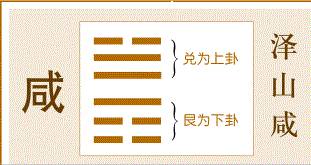 Image 1: Xian Hexagram (Image from Baidu)
Image 1: Xian Hexagram (Image from Baidu)
From the birth of all things to the peace of the world, it all relies on feeling. The commentary clearly defines Xian as feeling, so to understand feeling, we must start with Xian. In the “I Ching” system, Qian and Kun are the most basic hexagrams, and they are regarded as the original parents. From this pair of parents, six children are born, three males and three females. The three females are the Zui hexagram (young girl), Li hexagram (middle girl), and Xun hexagram (eldest girl); the three males are the Gen hexagram (young boy), Kan hexagram (middle boy), and Zhen hexagram (eldest boy). This pair of parents with six children constitutes the eight trigrams, also known as the eight meridian hexagrams. Then, the eight trigrams are paired to form the sixty-four hexagrams of the I Ching system. The Xian hexagram has the upper hexagram as the young girl (Zui) and the lower hexagram as the young boy (Gen). When the young girl meets the young boy, it is called Xian, also known as feeling, which is very subtle. Everyone might recall that when we first experience love, when a young girl meets a young boy (or vice versa), our faces turn red; this is the feeling! There is nothing messy about this; it is just a unique and sweet sensation. I see that some people are already recalling that moment, already immersed in the joy of it, which is truly a heart-to-heart connection.
The I Ching system has many hexagrams where females meet males, but only this hexagram is called Xian, which is worth exploring. The attraction between males and females, Yin and Yang, is a natural phenomenon, and this attraction in the Xian hexagram is described by Confucius as: “The two energies respond to each other, stopping and rejoicing (communicating joyfully).” Clearly, this attraction is beautiful, pure, powerful, and transcends mere romantic matters! From Xian, we can extend to Xianchi, which later evolved into the concept of peach blossoms, thus becoming entangled in the desires of men and women, leading to infinite suffering. Therefore, “stopping and rejoicing” is indeed thought-provoking.
The emotions of heaven and earth, the situations of all things, good and bad, all arise from the interaction of these two energies. The two energies, whether heaven and earth, or male and female, or hard and soft, are essentially Yin and Yang. And how do Yin and Yang interact? I think it is simply what the “Suwen” states: “From Yin to draw Yang, from Yang to draw Yin.” As mentioned earlier, these eight characters are the principles of Daoyin, and feeling is the key to Daoyin. Feeling, according to the “Kangxi Dictionary”, means “to touch”; when Yin and Yang (the two energies) touch, there is awareness, knowledge, and response, hence the terms sensation, perception, and response. Because of feeling, there is awareness; because of interaction, there is a connection, and there is power. Thus, feeling is a process that involves both awareness and power. By touching the Ren Meridian, Yin Qiao, and other Yin areas, it will first trigger awareness of the movement and stillness in the Yang areas, which is the process of feeling, and also the process of Daoyin. This movement and stillness, this awareness, and this power will become clearer as the feeling deepens and the Daoyin deepens.
I want to emphasize again that Daoyin is a skill, and as a skill, it requires time; it cannot be achieved overnight. I cannot guarantee that everyone will immediately experience such feelings, because through Xian, we can glimpse why the meeting of young girls and boys is defined as Xian. What qualities do young boys and girls possess? I think purity should be the most basic quality! Purity is the quality of young boys and girls, the basic condition needed for feeling, and it is also the fundamental requirement for Daoyin. Purity means being pure, simple, and unadulterated; this is what Daoyin should strive to achieve. Truth means being genuine and real; Daoyin must have authentic and personal feelings; without personal feelings, there can be no Daoyin.
Now we can try to experience this “feeling”. Please gently close your eyes. I usually relax and lie flat on my back, but now you can sit comfortably. We can place our fingers (mainly the index, middle, and ring fingers) opposite each other and touch the center line (Ren Meridian) with the pads of our fingers. This process is drawing from Yin, and whether the subsequent drawing of Yang occurs largely depends on our feeling! Of course, this “feeling” may not immediately appear at first, or it may not be very clear at the beginning, but it will gradually emerge and become clearer.
(After a few minutes of silence) Good! Everyone can slowly open your eyes. What do you feel? If you have feelings, please share with everyone. (Sharing omitted)
Some colleagues just shared their feelings about Anqiao and Daoyin; although these feelings are not identical, they are generally felt in the back (Yang area), which vividly describes “drawing Yang from Yin”. Earlier, we discussed that the feeling in the Daoyin process involves both awareness and power. Let’s first discuss awareness; this awareness has directional and target characteristics. This means it will first become aware of the problematic areas, and this process can also be seen as discovering problems. Discovering problems, especially early on, is quite important for health. Moreover, the problems discovered through Daoyin are often those that have not yet manifested in the body, which provides foresight! The awareness in Daoyin occurs simultaneously with the power, so while becoming aware of the problem, this power is also acting on the problem and resolving it. Furthermore, this power acts deeply; in my experience, external forces find it difficult to reach this depth. If through Daoyin, we can gradually cultivate the above awareness, then self-health and complete wellness will at least take the first step, and our self-awareness will also be established as a result.
Feeling is indeed a very important matter in Chinese culture. The term “feeling and communication” is also a very internal interpretation used by Confucius for the I Ching. The “I Ching: Commentary” states: “The I Ching is without thought, without action, silent and still, feeling and thus understanding the reasons for all things in the world.” How can many traditional things be understood? It can only be understood through feeling! The importance of characters in Chinese culture is also unique; we often say, “Literature carries the Dao”. The character for “I Ching” can illustrate this well. The character for “I” is composed of the sun above and the moon below; when the sun and moon are combined, it becomes brightness. Brightness represents wisdom, and the I Ching opens the study of bright virtue, thus being ultimate. The I Ching is placed at the forefront of all classics for this reason. Moreover, the sun represents Yang, and the moon represents Yin; Yin and Yang are the totality of manifestation, which is convenient. From the perspective of convenience, it is also the interaction of the two energies, which is also the interaction of the two energies, hence the feeling and communication, as well as the transportation. These are all principles of Daoyin and Anqiao.
Regarding “feeling”, there are many related terms, all of which have profound meanings, such as the above-mentioned feeling and communication. In terms of TCM, we pay special attention to “communication”; communication is almost synonymous with health! For example, the famous saying in the “Jin Kui Yao Lue”: “When the five zang organs are open and flowing, the person is peaceful and harmonious.” This illustrates this point well. But how to achieve communication? In the beginning of my lecture, I reported on the “Different Methods and Formulas”; it can be said that all are using different conveniences to achieve communication. Bian stones, poisons can achieve communication, nine needles, moxibustion can achieve communication, and Daoyin and Anqiao can also achieve communication. However, what is the difference between the five communications mentioned above? In general, the four communications outside of Daoyin rely on external forces, which may lead to overcorrection or excessive measures. However, the communication brought about by Daoyin is achieved through feeling; it is initiated from within, tailored to the individual, and is just right!
Additionally, terms like “feeling moved” and “feeling transformed” arise from feeling. Movement and stillness are relative concepts; movement can occur on a physical level as well as on a mental level. If it reaches the mental level, it can lead to emotional changes, causing sadness and tears; if it affects the physical level, it will influence Qi and blood. Comparatively, the physical level is shallower than the mental level, although both levels can interact, the mental level can more easily influence the physical level. Through the feeling of Daoyin, the first impact will certainly be on the physical body, which will then influence the mind, ultimately achieving interaction between body and mind. I want to suggest that the movement (or transformation) arising from feeling may even affect certain special physical forms. For example, tumors in the body can be affected by surgical knives or lasers; can they also be influenced by “feeling”? Can they be transformed through “feeling”? This is a question worth exploring.
In summary, Daoyin is indeed profound and subtle! The “Neijing” defines Daoyin as the method of the center, which highlights its profound meaning. This is a treasure bestowed upon the Chinese nation by the Yellow Emperor! If we cannot recognize it and enjoy it, we will be ashamed of the Yellow Emperor and our ancestors!
In this section, we opened the path of Daoyin through “Xian”. In Xian, we discussed young girls and boys, and purity, which is always inseparable from goodness and beauty. What is goodness and beauty? When our thoughts and actions are always for the benefit of all beings, purity arises from this, and goodness and beauty naturally emerge.
The above is my personal experience with Daoyin and Anqiao; of course, I have spoken quite roughly. Due to individual differences, discussing the finer details is still somewhat difficult. For example, the timing of Daoyin, the pressure applied during Daoyin, and the duration of staying at each location, etc., all need to be determined based on one’s own situation. In a word, follow your feelings!
However, there are two points I want to emphasize here: one is the Shanzhong point, which is an important point of the Ren Meridian, as well as the Mu point and Hui point of the Pericardium. In addition, Shanzhong is also one of the twelve officials; the “Suwen: Ling Lan Mi Dian Lun” refers to it as “the official of the minister, where joy and happiness emerge.” From this characteristic of Shanzhong, we can see that it is the source of our positive emotions. If we use more modern terms, Shanzhong is the source of positive energy! The modern competitive environment fills us with pressure, and many negative emotions cause too many people to fall into deep depression. Clearly, Shanzhong is the best official to lead these people out of depression!
The other is the Shenque point, which is also a major point of the Ren Meridian and the true center of the human body. Since Daoyin and Anqiao come from the center, Shenque is a place that needs to be considered carefully. The TCM system emphasizes that both form and spirit must be present to live a full life. Among form and spirit, spirit ranks first and is of utmost importance. Therefore, the acupuncture principle states: “The superior practitioner guards the spirit, while the inferior practitioner guards the form.” As the name suggests, Shenque is the place where the spirit enters and exits; if there are obstacles at this place, the spirit cannot enter and exit peacefully, which will naturally lead to serious consequences. Through Daoyin and Anqiao, maintaining the smoothness and cleanliness of Shenque allows the spirit to enter and exit freely, ensuring that the spirit remains vibrant.
From a theoretical perspective, the function of Daoyin and Anqiao is comprehensive, and it should be able to solve all problems. However, in practice, due to individual differences, not everyone can connect with it, nor can everyone find their feelings from it. Therefore, I hope that everyone can directly gain health from Daoyin and Anqiao, and I also hope that everyone can open their correct understanding of TCM and life through the principles of Daoyin and Anqiao!
This article is reprinted from the public account: Dr. Lai Meisheng of Traditional Chinese Medicine
